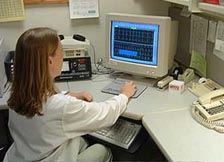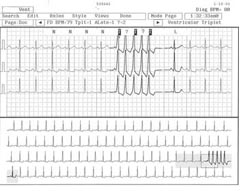Holter Monitoring
 Why is the doctor performing this procedure?
Why is the doctor performing this procedure?
A Holter monitor is used to monitor and record the heart’s electrical activity over a 24 hour period. An Event Recorder is the same type of monitor but allows recording of abnormal heart rhythms for one to two months.
What is the procedure?
The Holter monitor is a small ambulatory, portable ECG machine that can provide the following information:
- The heart’s rhythm over a 24-hour period, during normal activities, or recording gets triggered by the patient when a specific event occurs. An event recorder can be used for a much longer period of time.
- Correlate any symptoms (chest pain, palpitations, etc) the patient experiences with the heart’s electrical activity at that time.
- Record any abnormal heart rhythms (arrhythmias) that occur, providing diagnostic information about the type of arrhythmia, how long it lasts, and what might trigger it.
- Determine how well anti-arrhythmia medicines are working.
The Holter monitor is worn over a 24-hour period while the patient does all of his/her normal activities. Small, sticky patches called electrodes are attached to the chest. Wires travel from the electrodes to a small portable box that is worn on the belt or shoulder strap. The box records and stores continuous heart rhythm data transmitted by  the electrodes. The patient must keep a diary of activities, and of any symptoms, that occur while the monitor is in place. This will allow the doctor to correlate activities with symptoms with the heart’s electrical rhythm at a specific point in time. The patient will also be advised of how to care for the monitor while wearing it. When the 24-hour period is completed, or longer for the event monitor, the patient returns the Holter monitor to the hospital, and a technician does a computerized analysis of the Holter monitor data to prepare a thorough report for the physician.
the electrodes. The patient must keep a diary of activities, and of any symptoms, that occur while the monitor is in place. This will allow the doctor to correlate activities with symptoms with the heart’s electrical rhythm at a specific point in time. The patient will also be advised of how to care for the monitor while wearing it. When the 24-hour period is completed, or longer for the event monitor, the patient returns the Holter monitor to the hospital, and a technician does a computerized analysis of the Holter monitor data to prepare a thorough report for the physician.
Useful tips for better recording quality.
- Wear a two piece outfit, preferably a shirt with buttons on the front
- Try to sleep on your back with the recorder positioned at your side so that the electrodes are not pulled off..
- Do not get the electrodes, wires or monitor wet.
- If you have a hairy chest, the areas where the electrodes are placed will need to be shaved.
- Avoid electric blankets, magnets, metal detectors, and high voltage areas such as power lines. Signals from such devices may affect recording.
- It is important that you keep the electrodes and wires attached for the entire recording. If an electrode comes off, stick it back on your skin.
Where is the test performed?
The Holter monitor is placed and removed at the hospital. The actual testing period occurs at the patient’s home (or wherever the usual daily routine dictates).
How long does this test take?
The holter monitor placement takes about 10 to 20 minutes to complete.
Surgeries
- Abdominal Aortic Aneurysm Repair
- Bypass Surgery
- Carotid Endarterectomy (CEA)
- Coronary Artery Bypass Surgery (CABG)
- Transmyocardial Revascularization (TMR)
- Valve Repair Surgery
- Valve Replacement Surgery
Procedures
- Ablation
- Angiojet Thrombectomy
- Aortagram
- Atherectomy
- Automatic Implantable Cardioverter Defibrillators (AICD or ICD)
- Coil Embolization
- Computed Axial Tomography (CAT or CT)/Ultrafact Computed Tomography (CT) Scan
- Coronary Balloon Angioplasty & Stenting
- Coronary Catheterization
- Dobutamine Stress Echo
- Echocardiography (ECHO)
- Electrocardiogram (EKG/ECG)
- Electrophysiology Study (EPS)
- Event Recorder
- Holter Monitoring
- Inferior Vena Cava (IVC) Umbrella Placement
- Intraaortic Balloon Pump
- Intracardiac Ultrasound (ICE)
- Intravascular Ultrasound (ICE)
- Magnetic Resonance Imaging (MRI)/ Magnetic Resonance Angiography (MRA)
- Medicated Stents
- Nuclear Stress Tests
- Pacemakers
- Percutaneous Transluminal Angioplasty (PTA)
- Percutaneous Transluminal Coronary Angioplasty (PTCA)
- Peripheral Stents
- Peripheral Vascular Angiography
- Radiation Brachytherapy
- Septal Closures
- Signal Averaged Electrocardiogram (SAECG)
- Stents
- Stress Echocardiogram
- Stress Test
- Thrombolytic Treatment
- Tilt Table
- Transesophageal Echocardiogram (TEE)
- Valvuloplasty
